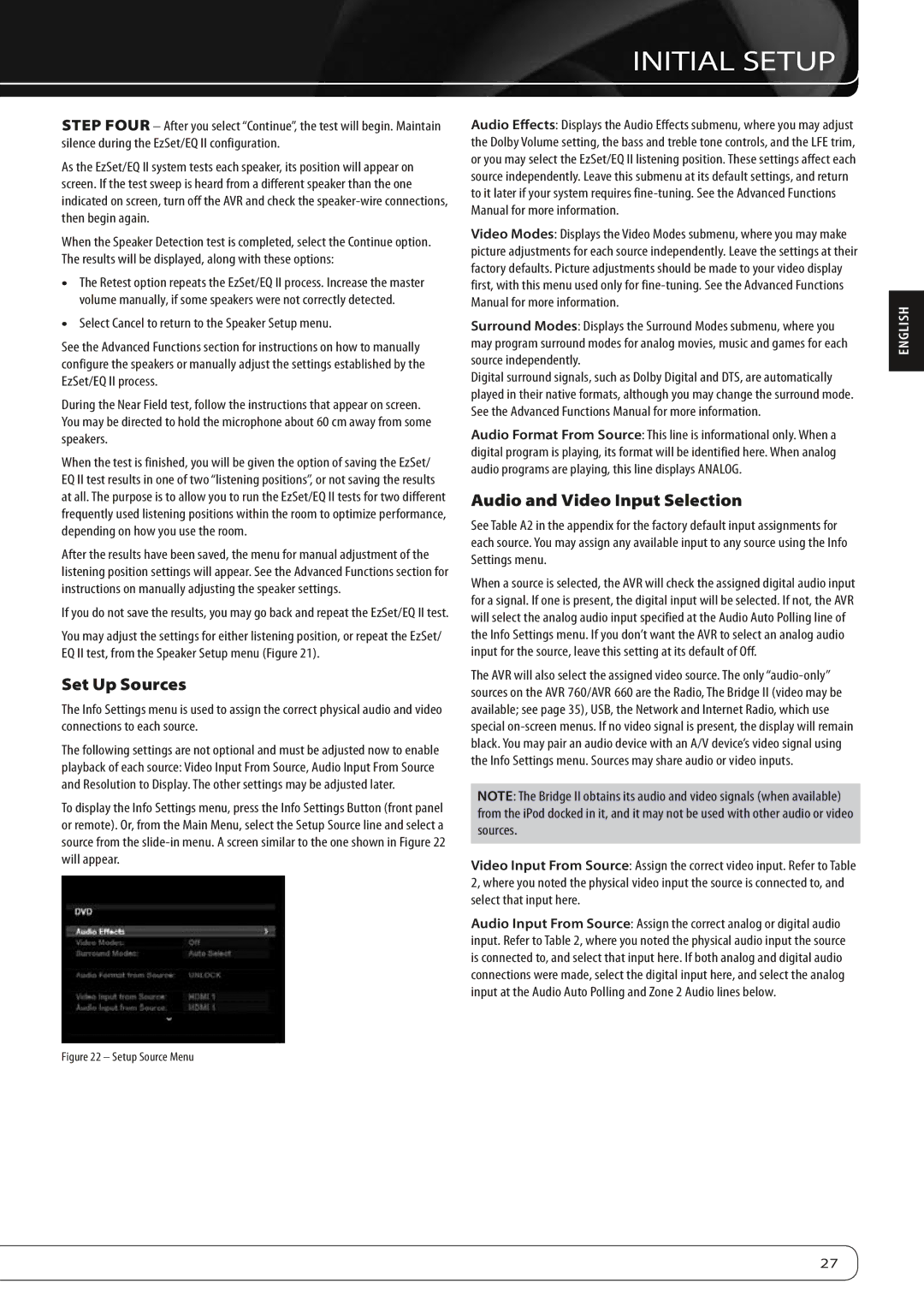Step Four – After you select “Continue”, the test will begin. Maintain silence during the EzSet/EQ II configuration.
As the EzSet/EQ II system tests each speaker, its position will appear on screen. If the test sweep is heard from a different speaker than the one indicated on screen, turn off the AVR and check the speaker-wire connections, then begin again.
When the Speaker Detection test is completed, select the Continue option. The results will be displayed, along with these options:
•• The Retest option repeats the EzSet/EQ II process. Increase the master volume manually, if some speakers were not correctly detected.
•• Select Cancel to return to the Speaker Setup menu.
See the Advanced Functions section for instructions on how to manually configure the speakers or manually adjust the settings established by the EzSet/EQ II process.
During the Near Field test, follow the instructions that appear on screen. You may be directed to hold the microphone about 60 cm away from some speakers.
When the test is finished, you will be given the option of saving the EzSet/ EQ II test results in one of two “listening positions”, or not saving the results at all. The purpose is to allow you to run the EzSet/EQ II tests for two different frequently used listening positions within the room to optimize performance, depending on how you use the room.
After the results have been saved, the menu for manual adjustment of the listening position settings will appear. See the Advanced Functions section for instructions on manually adjusting the speaker settings.
If you do not save the results, you may go back and repeat the EzSet/EQ II test.
You may adjust the settings for either listening position, or repeat the EzSet/ EQ II test, from the Speaker Setup menu (Figure 21).
Set Up Sources
The Info Settings menu is used to assign the correct physical audio and video connections to each source.
The following settings are not optional and must be adjusted now to enable playback of each source: Video Input From Source, Audio Input From Source and Resolution to Display. The other settings may be adjusted later.
To display the Info Settings menu, press the Info Settings Button (front panel or remote). Or, from the Main Menu, select the Setup Source line and select a source from the slide-in menu. A screen similar to the one shown in Figure 22 will appear.
INITIAL SETUP
Audio Effects: Displays the Audio Effects submenu, where you may adjust the Dolby Volume setting, the bass and treble tone controls, and the LFE trim, or you may select the EzSet/EQ II listening position. These settings affect each source independently. Leave this submenu at its default settings, and return to it later if your system requires fine-tuning. See the Advanced Functions Manual for more information.
Video Modes: Displays the Video Modes submenu, where you may make picture adjustments for each source independently. Leave the settings at their factory defaults. Picture adjustments should be made to your video display first, with this menu used only for fine-tuning. See the Advanced Functions Manual for more information.
Surround Modes: Displays the Surround Modes submenu, where you may program surround modes for analog movies, music and games for each source independently.
Digital surround signals, such as Dolby Digital and DTS, are automatically played in their native formats, although you may change the surround mode. See the Advanced Functions Manual for more information.
Audio Format From Source: This line is informational only. When a digital program is playing, its format will be identified here. When analog audio programs are playing, this line displays ANALOG.
Audio and Video Input Selection
See Table A2 in the appendix for the factory default input assignments for each source. You may assign any available input to any source using the Info Settings menu.
When a source is selected, the AVR will check the assigned digital audio input for a signal. If one is present, the digital input will be selected. If not, the AVR will select the analog audio input specified at the Audio Auto Polling line of the Info Settings menu. If you don’t want the AVR to select an analog audio input for the source, leave this setting at its default of Off.
The AVR will also select the assigned video source. The only “audio-only” sources on the AVR 760/AVR 660 are the Radio, The Bridge II (video may be available; see page 35), USB, the Network and Internet Radio, which use special on-screen menus. If no video signal is present, the display will remain black. You may pair an audio device with an A/V device’s video signal using the Info Settings menu. Sources may share audio or video inputs.
NOTE: The Bridge II obtains its audio and video signals (when available) from the iPod docked in it, and it may not be used with other audio or video sources.
Video Input From Source: Assign the correct video input. Refer to Table 2, where you noted the physical video input the source is connected to, and select that input here.
Audio Input From Source: Assign the correct analog or digital audio input. Refer to Table 2, where you noted the physical audio input the source is connected to, and select that input here. If both analog and digital audio connections were made, select the digital input here, and select the analog input at the Audio Auto Polling and Zone 2 Audio lines below.

